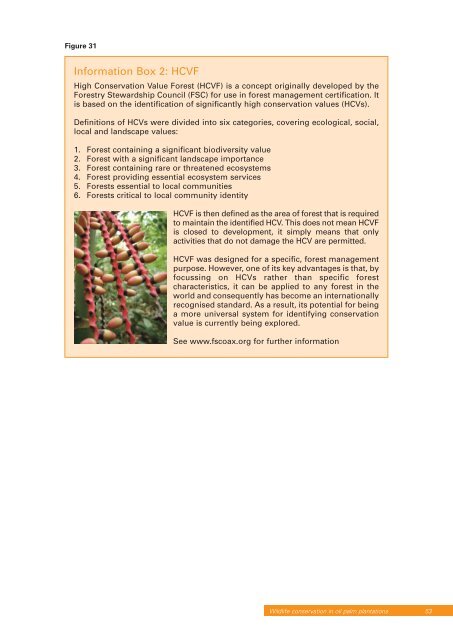The conservation of tigers and other wildlife in oil palm plantations
The conservation of tigers and other wildlife in oil palm plantations
The conservation of tigers and other wildlife in oil palm plantations
Create successful ePaper yourself
Turn your PDF publications into a flip-book with our unique Google optimized e-Paper software.
Figure 31<br />
Information Box 2: HCVF<br />
High Conservation Value Forest (HCVF) is a concept orig<strong>in</strong>ally developed by the<br />
Forestry Stewardship Council (FSC) for use <strong>in</strong> forest management certification. It<br />
is based on the identification <strong>of</strong> significantly high <strong>conservation</strong> values (HCVs).<br />
Def<strong>in</strong>itions <strong>of</strong> HCVs were divided <strong>in</strong>to six categories, cover<strong>in</strong>g ecological, social,<br />
local <strong>and</strong> l<strong>and</strong>scape values:<br />
1. Forest conta<strong>in</strong><strong>in</strong>g a significant biodiversity value<br />
2. Forest with a significant l<strong>and</strong>scape importance<br />
3. Forest conta<strong>in</strong><strong>in</strong>g rare or threatened ecosystems<br />
4. Forest provid<strong>in</strong>g essential ecosystem services<br />
5. Forests essential to local communities<br />
6. Forests critical to local community identity<br />
HCVF is then def<strong>in</strong>ed as the area <strong>of</strong> forest that is required<br />
to ma<strong>in</strong>ta<strong>in</strong> the identified HCV. This does not mean HCVF<br />
is closed to development, it simply means that only<br />
activities that do not damage the HCV are permitted.<br />
HCVF was designed for a specific, forest management<br />
purpose. However, one <strong>of</strong> its key advantages is that, by<br />
focuss<strong>in</strong>g on HCVs rather than specific forest<br />
characteristics, it can be applied to any forest <strong>in</strong> the<br />
world <strong>and</strong> consequently has become an <strong>in</strong>ternationally<br />
recognised st<strong>and</strong>ard. As a result, its potential for be<strong>in</strong>g<br />
a more universal system for identify<strong>in</strong>g <strong>conservation</strong><br />
value is currently be<strong>in</strong>g explored.<br />
See www.fscoax.org for further <strong>in</strong>formation<br />
Wildlife <strong>conservation</strong> <strong>in</strong> <strong>oil</strong> <strong>palm</strong> <strong>plantations</strong> 53

















